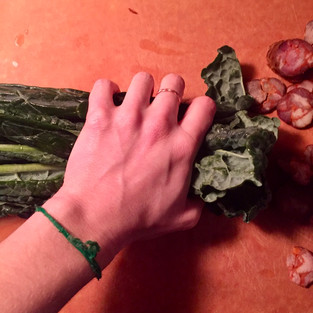Vovó’s Caldo Verde: A Traditional Recipe
- liveLUSO
- Nov 18, 2021
- 4 min read
Updated: Apr 13, 2023
Learn how to make this quintessential Portuguese soup with a special, easy-to-follow recipe from our vovó (grandma).

An Iconic Portuguese Soup with Humble Origins
There’s nothing like a piping hot bowl of caldo verde to warm your soul on a cold day. Originally from the Minho region in northern Portugal, this iconic soup is eaten year-round, rain or shine. Though it may be simple, caldo verde was included in Portugal’s Sete Maravilhas de Gastronomia, a nationally-recognized list of Portugal's seven culinary wonders.
As a culinary wonder, the Portuguese people sing its praises — quite literally. In Portugal's unofficial anthem, "Uma Casa Portuguesa," Amália Rodrigues, the Queen of Fado music herself, sings the following refrain:
Basta pouco poucochinho pra alegrar (Little is needed to rejoice)
Uma existência singela (a simple existence)
É só amor pão e vinho (Just love, bread, and wine)
E um caldo verde verdinho (And caldo verde)
A fumegar na tigela (steaming in a bowl)
Perhaps caldo verde is so beloved because like the Portuguese people, its roots are humble. The foundation includes nothing more than water, potato, onion, and couves (a Portuguese cabbage most similar to collard greens or kale). The result? A subtle tasting broth with slivers of sharp greens often topped with pieces of linguiça, a Portuguese smoked sausage.
Making Caldo Verde Your Own
Many restaurants and cafés throughout Portugal serve caldo verde. But as every Portuguese person knows, the best caldo verde is the one that vovó (grandma) makes.
This recipe is as purest as it gets, using just four ingredients to make a traditional bowl of caldo verde.
But if your vovó hasn’t taught you how to make her famous caldo verde yet, here’s a recipe you can try from ours. This recipe is as purest as it gets, using just four ingredients to create a solid base (plus two optional ingredients) for a traditional bowl of caldo verde.
Once you’ve mastered this recipe, you can get creative and adjust some of the ingredients and quantities to make it your own. Some cook garlic with the potatoes and onions before blending. Others add shallots to build a more complex broth. You could even replace the onion with leeks for a more intense flavor profile.
When ready, you can top off your caldo verde with chopped linguiça, freshly ground pepper and olive oil. Serve it up in a small bowl as a delicious appetizer. Or if you’re in the mood for a light dinner, fill up a large soup bowl and enjoy your caldo verde with a slice of bread (even better if it’s Portuguese corn bread).
IMPORTANT TIP: The one thing you shouldn't replace in this recipe are the russet potatoes. Russet potatoes will give you the proper consistency and taste needed for a traditional caldo verde broth.
P.S. We did our best to provide exact quantities and cooking times. If you’ve tried getting a recipe from a Portuguese grandmother, you’ll know that they never measure anything. Everything is added by feel and by look — true soul cooking if you ask us.
Looking for a new soup bowl to serve your homemade caldo verde? Add these Portuguese soup bowls from Etsy to your dish ware. As an affiliate partner, we may receive a small commission if you make a purchase. Thank you for supporting us!
Caldo Verde Recipe
Level: Easy
Servings: 4 - 6 servings
Prep & Cook Time: 10 minutes prep time; ~ 30 min cook time
Ingredients:
1 head of lacinato/dinosaur kale (you can use any kind of kale or collard greens but this is the most similar to couves in our opinion)
2 medium russet potatoes, peeled
1 yellow onion
salt (to taste)
olive oil (optional)
linguiça (optional)
Directions:
1. Boil 4 cups of salted water in a large pot.
2. Peel the russet potatoes and chop into squares. Peel the onion and chop into fourths.
You can leave the potatoes whole but this will increase the cooking time.
3. Once the water is at a rolling boil, add potatoes and onion. The water should just cover the potatoes and onion. If you have too much water, empty out the extra amount. This is also a good time to add a little more salt. Cover the pot and lower the heat a little while maintaining a boil. Cook until potatoes can be easily pierced with a fork (about 10 - 15 minutes).
4. While the onions and potatoes are boiling, rinse the kale and chop off the thickest part of the stems. Roll the kale (like a fruit roll up) and slice as thinly as you can. Then roughly chop into smaller chunks so you don't end up with long strings of kale. To this day, my great grandmother says I don’t slice the kale thinly enough.
5. When the potatoes and onions are done, blend until smooth with a hand blender. Or place in a blender for an ultra smooth broth. You should feel slight resistance when you run a spoon through the broth.
If the broth is too thick, add water to thin it out.
6. Once fully blended, taste the broth. Add a hefty dash of salt and taste again. Continue adding salt until the broth tastes full-bodied.
7. Return broth to the stove over medium heat (not a rolling boil). Add kale and cook for 7 - 10 minutes until kale is wilted and no longer tough.
8. Once kale is cooked, top off the soup will a dash of olive oil. This step is optional but our vovó always does it, so we do it. (You can also add freshly ground pepper).
9. To make your caldo verde heartier, add thinly sliced linguiça on top. If the slices are thin enough, the hot soup will warm them up. Or you can lightly fry the linguiça in a pan first, adding even more flavor!

That's it! You’re done! Serve as an appetizer or as a meal with a Portuguese bread. For the best taste, store in the refrigerator and serve the next day. The flavors really build overnight. And freeze any leftovers to defrost on a rainy day!
Do you have a zest for Portuguese culture? An unbridled joy for the charisma of Portugal's people and traditions? Become a Patron of Portuguese Culture and join those who share your passion to support liveLUSO, the first online Portuguese community.















